run flat DODGE JOURNEY 2019 Vehicle Warranty
[x] Cancel search | Manufacturer: DODGE, Model Year: 2019, Model line: JOURNEY, Model: DODGE JOURNEY 2019Pages: 270, PDF Size: 2.52 MB
Page 75 of 270

•If an unusual vibration or vehicle handling difficulty arises, stop
driving as soon as safely and reasonably possible. The tire may be
about to suddenly fail. Release the accelerator and gradually reduce
speed. The tire will need to be replaced before proceeding.
• If towing a trailer, stop driving as soon as safely and reasonably
possible. In this condition, it is potentially dangerous to operate a
vehicle/trailer combination. If possible, disconnect the trailer and
proceed as noted above. Do not continue to tow any trailer until proper
tire service or replacement has been performed.
• Do not touch a tire recently run-low or run-flat (it may be very hot).
Allow the tire to cool before handling.
DISTANCE—HOW FAR YOU CAN DRIVE
Factors affecting run-flat or low tire pressure operating distance include
vehicle speed, load, and maneuvering; the amount of inflation pressure
loss; the extent of any tire damage; and ambient temperature.
The tire may be marked on the sidewall with run-flat or low tire pressure
operating speed and/or distance limitations, which vary by tire design
and vehicle application (consult your vehicle owner ’s manual). By
international standard, RFT tires have a baseline limitation in run-flat
mode of the following:
Maximum Speed: 50 mph (80 km/h)
Maximum Distance: 50 miles (80 km)
NOTE:
•Maximum distance values are determined under controlled condi-
tions, which may vary in actual use.
• Your mileage capability may be less, or more, depending on your
specific operating conditions.
• If in doubt, do not exceed the 50 mile (80 km) limitation.
• Seek tire service as soon as possible to minimize tire damage.
BRIDGESTONE® - FIRESTONE®
74
Page 76 of 270

SPECIAL SERVICE AND REPAIR ISSUES
Run-Flat Certified Retailers
Because of the advanced technology and design of RFT tires and the
required tire pressure monitoring systems (TPMS), Bridgestone Firestone
Run-Flat Certified Retailers are specially trained to sell and service RFT
tires.
Run-Flat Certified Retailers have the necessary equipment and are
specially trained to properly mount and demount RFT tires and to handle
TPMS devices.Conventional mounting equipment may irreparably
damage RFT tires and an improper repair is unsafe and will void the
Limited Warranty. Accordingly, it is important to go to a Bridgestone
Firestone Run-Flat Certified Retailer for tire maintenance and replace-
ment.
Call toll-free 1-877-BFS-4RFT or, 877-237-4738 or visit
www.bridgestonetire.comto locate the nearest Bridgestone Firestone
Run-Flat Certified Retailer.
Inspection after Run-Flat or Low Pressure Operation
Following run-flat or low tire pressure operation, or in the event of any
other tire damage or unusual condition, it is very important to obtain a
proper and complete tire evaluation as soon as possible.
Rotation
Follow the vehicle manufacturer ’s recommendations, or rotate every
5,000 miles per the recommendations in this manual (see “Radial Tire
Rotation”). In some cases, TPMS devices require reprogramming with
each tire rotation.
RFT Tire Replacement
Do not replace or mix RFT tires with conventional tires, unless on an
emergency/temporary basis. Conventional tires do not have run-flat
capability and the handling characteristics of the vehicle with these tires
may be different. If a conventional tire is used on an emergency/
temporary basis, verify that its size, load capacity, inflation pressure, and
speed rating specifications meet the requirements of the vehicle. Replace
any conventional tire with the proper RFT tire as soon as possible.
BRIDGESTONE® - FIRESTONE®
75
Page 77 of 270
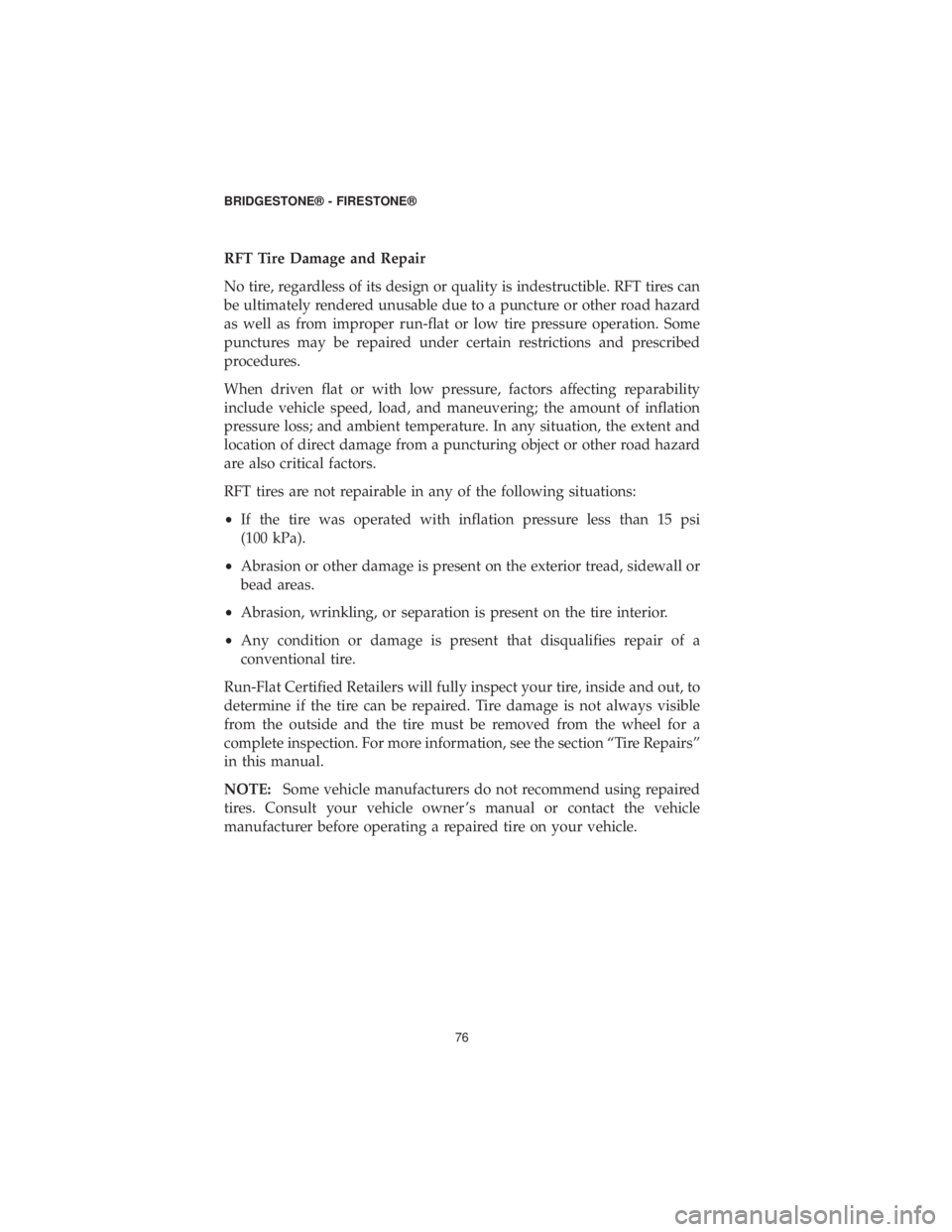
RFT Tire Damage and Repair
No tire, regardless of its design or quality is indestructible. RFT tires can
be ultimately rendered unusable due to a puncture or other road hazard
as well as from improper run-flat or low tire pressure operation. Some
punctures may be repaired under certain restrictions and prescribed
procedures.
When driven flat or with low pressure, factors affecting reparability
include vehicle speed, load, and maneuvering; the amount of inflation
pressure loss; and ambient temperature. In any situation, the extent and
location of direct damage from a puncturing object or other road hazard
are also critical factors.
RFT tires are not repairable in any of the following situations:
•If the tire was operated with inflation pressure less than 15 psi
(100 kPa).
• Abrasion or other damage is present on the exterior tread, sidewall or
bead areas.
• Abrasion, wrinkling, or separation is present on the tire interior.
• Any condition or damage is present that disqualifies repair of a
conventional tire.
Run-Flat Certified Retailers will fully inspect your tire, inside and out, to
determine if the tire can be repaired. Tire damage is not always visible
from the outside and the tire must be removed from the wheel for a
complete inspection. For more information, see the section “Tire Repairs”
in this manual.
NOTE: Some vehicle manufacturers do not recommend using repaired
tires. Consult your vehicle owner ’s manual or contact the vehicle
manufacturer before operating a repaired tire on your vehicle.
BRIDGESTONE® - FIRESTONE®
76
Page 82 of 270
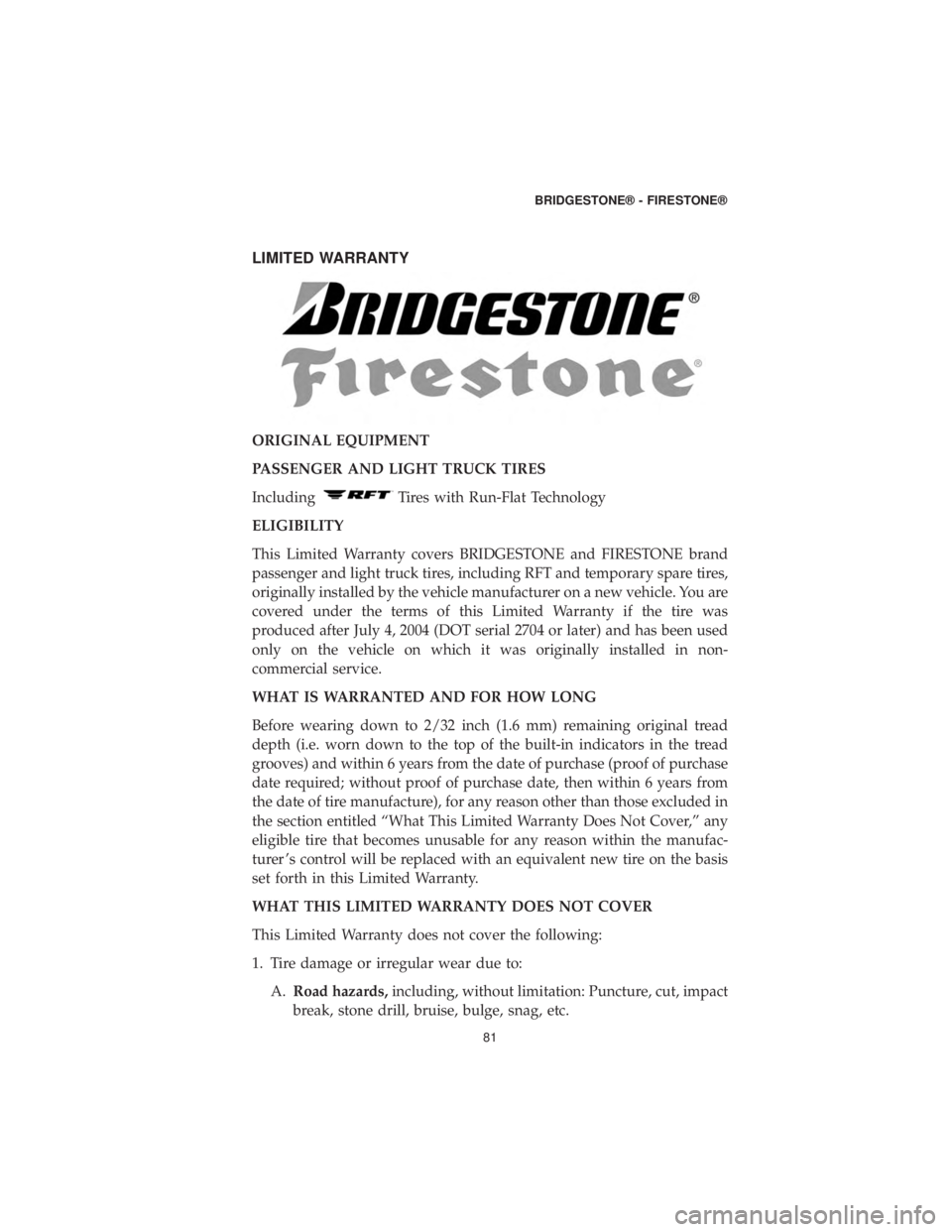
LIMITED WARRANTY
ORIGINAL EQUIPMENT
PASSENGER AND LIGHT TRUCK TIRES
Including
Tires with Run-Flat Technology
ELIGIBILITY
This Limited Warranty covers BRIDGESTONE and FIRESTONE brand
passenger and light truck tires, including RFT and temporary spare tires,
originally installed by the vehicle manufacturer on a new vehicle. You are
covered under the terms of this Limited Warranty if the tire was
produced after July 4, 2004 (DOT serial 2704 or later) and has been used
only on the vehicle on which it was originally installed in non-
commercial service.
WHAT IS WARRANTED AND FOR HOW LONG
Before wearing down to 2/32 inch (1.6 mm) remaining original tread
depth (i.e. worn down to the top of the built-in indicators in the tread
grooves) and within 6 years from the date of purchase (proof of purchase
date required; without proof of purchase date, then within 6 years from
the date of tire manufacture), for any reason other than those excluded in
the section entitled “What This Limited Warranty Does Not Cover,” any
eligible tire that becomes unusable for any reason within the manufac-
turer ’s control will be replaced with an equivalent new tire on the basis
set forth in this Limited Warranty.
WHAT THIS LIMITED WARRANTY DOES NOT COVER
This Limited Warranty does not cover the following:
1. Tire damage or irregular wear due to: A. Road hazards, including, without limitation: Puncture, cut, impact
break, stone drill, bruise, bulge, snag, etc.
BRIDGESTONE® - FIRESTONE®
81
Page 83 of 270
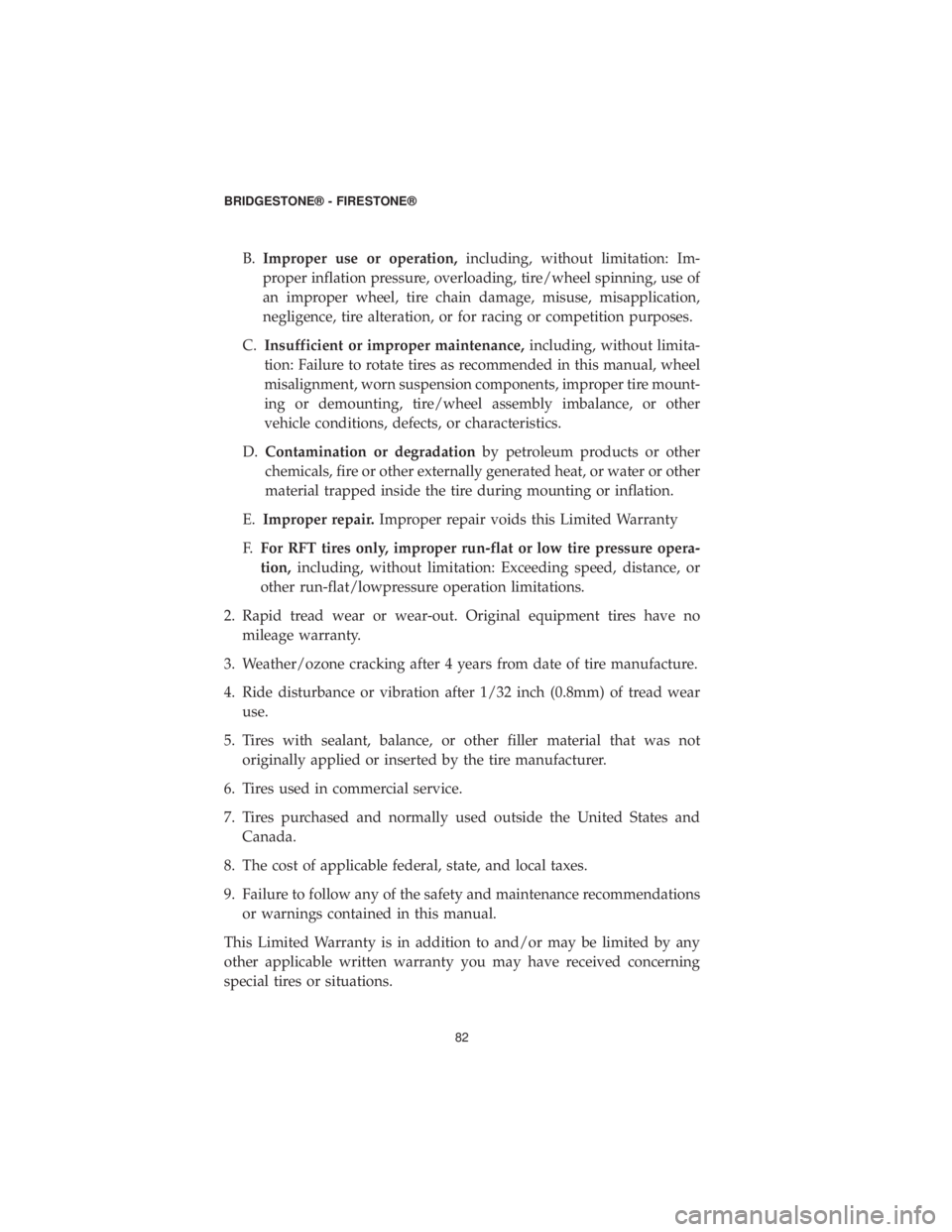
B.Improper use or operation, including, without limitation: Im-
proper inflation pressure, overloading, tire/wheel spinning, use of
an improper wheel, tire chain damage, misuse, misapplication,
negligence, tire alteration, or for racing or competition purposes.
C. Insufficient or improper maintenance, including, without limita-
tion: Failure to rotate tires as recommended in this manual, wheel
misalignment, worn suspension components, improper tire mount-
ing or demounting, tire/wheel assembly imbalance, or other
vehicle conditions, defects, or characteristics.
D. Contamination or degradation by petroleum products or other
chemicals, fire or other externally generated heat, or water or other
material trapped inside the tire during mounting or inflation.
E. Improper repair. Improper repair voids this Limited Warranty
F. For RFT tires only, improper run-flat or low tire pressure opera-
tion, including, without limitation: Exceeding speed, distance, or
other run-flat/lowpressure operation limitations.
2. Rapid tread wear or wear-out. Original equipment tires have no mileage warranty.
3. Weather/ozone cracking after 4 years from date of tire manufacture.
4. Ride disturbance or vibration after 1/32 inch (0.8mm) of tread wear use.
5. Tires with sealant, balance, or other filler material that was not originally applied or inserted by the tire manufacturer.
6. Tires used in commercial service.
7. Tires purchased and normally used outside the United States and Canada.
8. The cost of applicable federal, state, and local taxes.
9. Failure to follow any of the safety and maintenance recommendations or warnings contained in this manual.
This Limited Warranty is in addition to and/or may be limited by any
other applicable written warranty you may have received concerning
special tires or situations.
BRIDGESTONE® - FIRESTONE®
82
Page 93 of 270
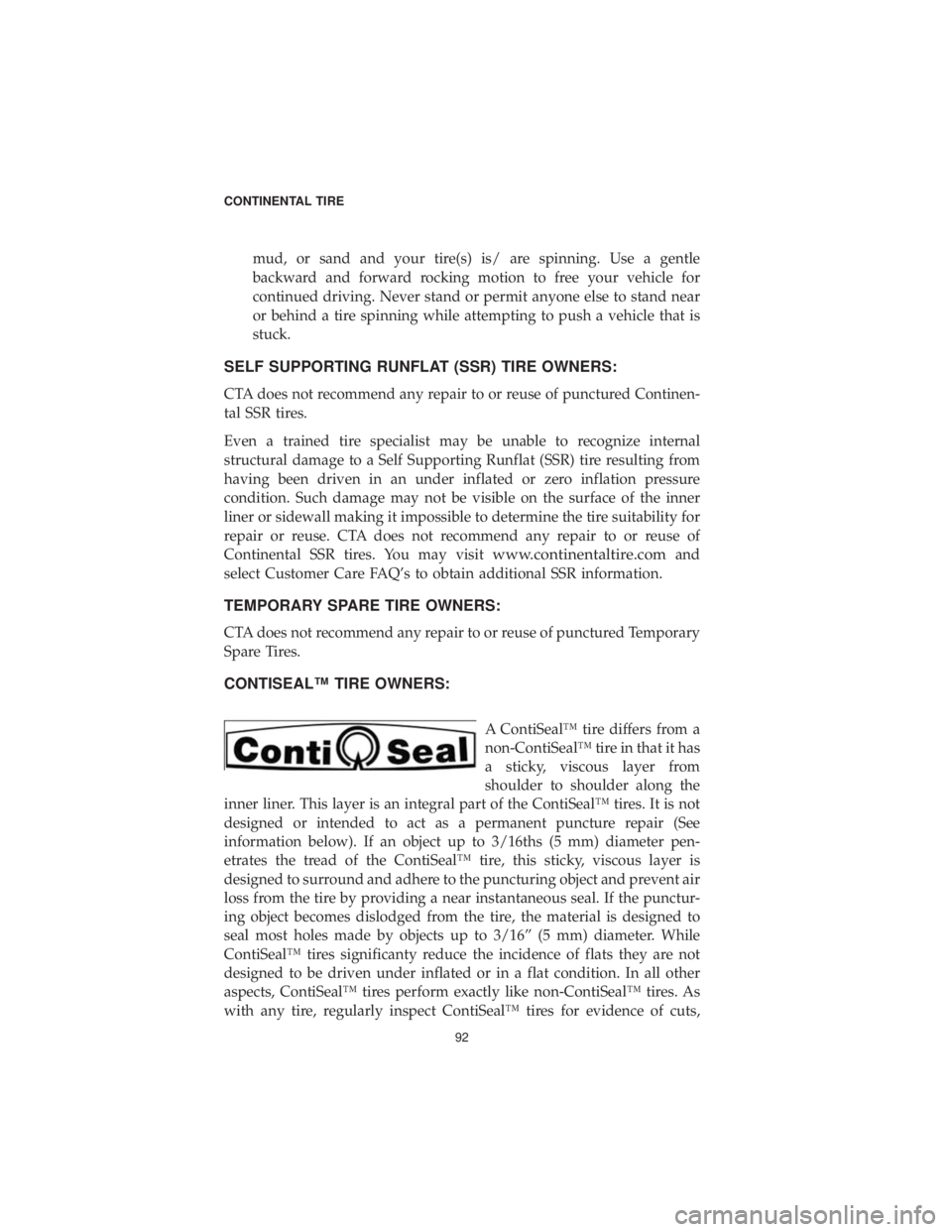
mud, or sand and your tire(s) is/ are spinning. Use a gentle
backward and forward rocking motion to free your vehicle for
continued driving. Never stand or permit anyone else to stand near
or behind a tire spinning while attempting to push a vehicle that is
stuck.
SELF SUPPORTING RUNFLAT (SSR) TIRE OWNERS:
CTA does not recommend any repair to or reuse of punctured Continen-
tal SSR tires.
Even a trained tire specialist may be unable to recognize internal
structural damage to a Self Supporting Runflat (SSR) tire resulting from
having been driven in an under inflated or zero inflation pressure
condition. Such damage may not be visible on the surface of the inner
liner or sidewall making it impossible to determine the tire suitability for
repair or reuse. CTA does not recommend any repair to or reuse of
Continental SSR tires. You may visit
www.continentaltire.comand
select Customer Care FAQ’s to obtain additional SSR information.
TEMPORARY SPARE TIRE OWNERS:
CTA does not recommend any repair to or reuse of punctured Temporary
Spare Tires.
CONTISEAL™ TIRE OWNERS:
A ContiSeal™ tire differs from a
non-ContiSeal™ tire in that it has
a sticky, viscous layer from
shoulder to shoulder along the
inner liner. This layer is an integral part of the ContiSeal™ tires. It is not
designed or intended to act as a permanent puncture repair (See
information below). If an object up to 3/16ths (5 mm) diameter pen-
etrates the tread of the ContiSeal™ tire, this sticky, viscous layer is
designed to surround and adhere to the puncturing object and prevent air
loss from the tire by providing a near instantaneous seal. If the punctur-
ing object becomes dislodged from the tire, the material is designed to
seal most holes made by objects up to 3/16” (5 mm) diameter. While
ContiSeal™ tires significanty reduce the incidence of flats they are not
designed to be driven under inflated or in a flat condition. In all other
aspects, ContiSeal™ tires perform exactly like non-ContiSeal™ tires. As
with any tire, regularly inspect ContiSeal™ tires for evidence of cuts,
CONTINENTAL TIRE
92
Page 104 of 270

2.WHAT IS NOT COVERED BY THE WARRANTY
A. Tires that becomes unserviceable due to road hazard damages (cuts, snags, punctures, bruises, impact breaks, etc.) improper
repair technique or materials, improper inflation, overload, irregu-
lar wear, wheel imbalance, defective mechanical vehicle compo-
nents (brakes, suspension, wheels, etc.) improper suspension align-
ment, accident, fire, chemical damage, damage from chain use,
racing, off-road use, run flat, improper installation, vandalism, or
abuse.
B. Tires branded “NA” or a tire in which the DOT numbering has been removed.
C. Tires presented for a warranty claim by someone other than by the original purchaser, or tires that were transferred to another vehicle
from the vehicle in which the tires were originally installed.
D. Tires having a failure or failures caused by a previous damages or repairs.
E. The cost of tire repair or retreading is not covered by this warranty and will be the sole responsibility of the tire owner.
Possible NON Covered Reasons/Conditions due to:
Chipping/Chunking/Tearing Puncture
Corrosion/Wreck Racing or any Competition
Fire Repair Failure
Impact Break or Concussions Road Hazards
Improper Inflation Pressure Sidewall Cut or Damage
Improper Mounting/Dismount Theft or Vandalism
Mechanical Defects of the Vehicle Tread Cuts
Misalignment Wheel Imbalance
Misapplication Willful Abuse
Overloading FALKEN TIRE CORPORATION
103
Page 130 of 270
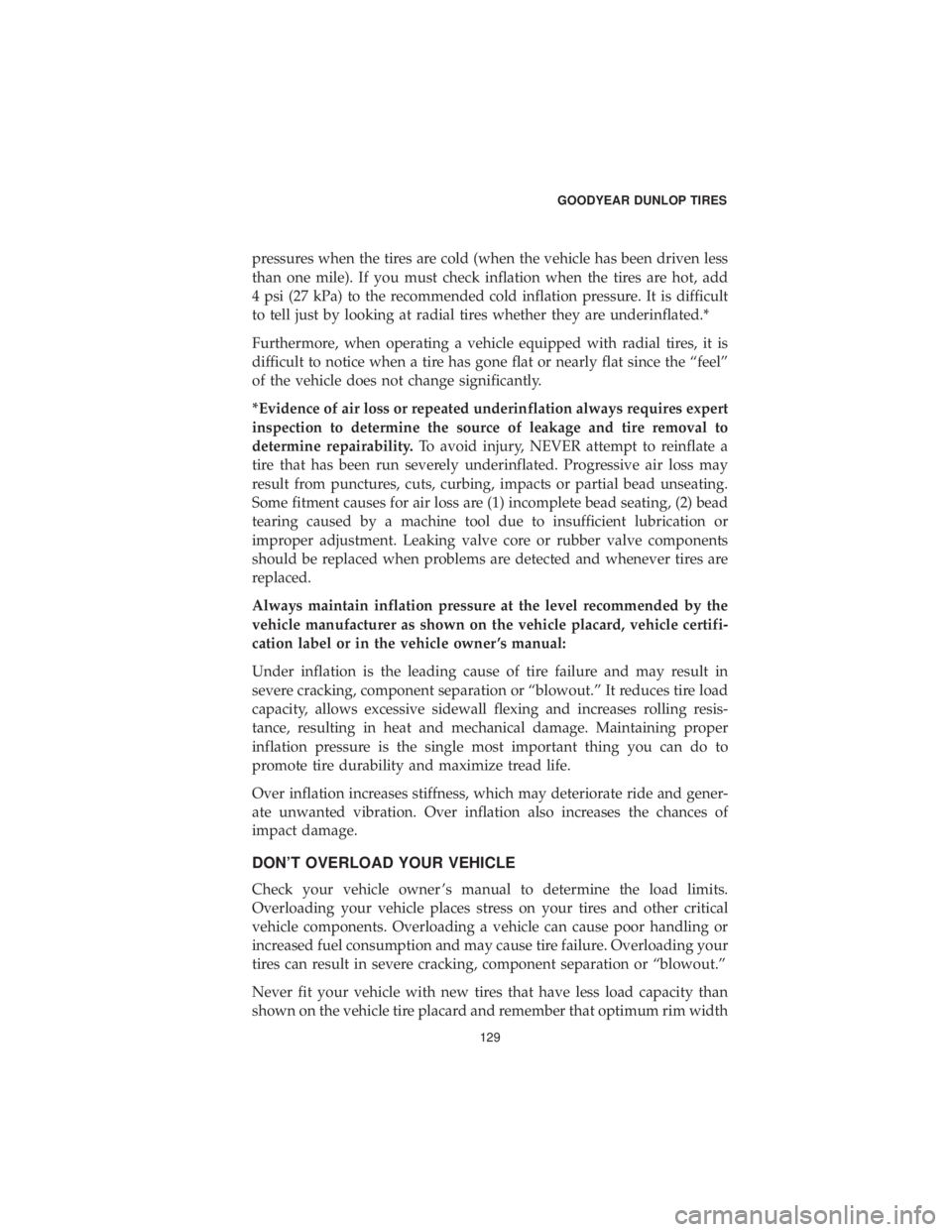
pressures when the tires are cold (when the vehicle has been driven less
than one mile). If you must check inflation when the tires are hot, add
4 psi (27 kPa) to the recommended cold inflation pressure. It is difficult
to tell just by looking at radial tires whether they are underinflated.*
Furthermore, when operating a vehicle equipped with radial tires, it is
difficult to notice when a tire has gone flat or nearly flat since the “feel”
of the vehicle does not change significantly.
*Evidence of air loss or repeated underinflation always requires expert
inspection to determine the source of leakage and tire removal to
determine repairability.To avoid injury, NEVER attempt to reinflate a
tire that has been run severely underinflated. Progressive air loss may
result from punctures, cuts, curbing, impacts or partial bead unseating.
Some fitment causes for air loss are (1) incomplete bead seating, (2) bead
tearing caused by a machine tool due to insufficient lubrication or
improper adjustment. Leaking valve core or rubber valve components
should be replaced when problems are detected and whenever tires are
replaced.
Always maintain inflation pressure at the level recommended by the
vehicle manufacturer as shown on the vehicle placard, vehicle certifi-
cation label or in the vehicle owner ’s manual:
Under inflation is the leading cause of tire failure and may result in
severe cracking, component separation or “blowout.” It reduces tire load
capacity, allows excessive sidewall flexing and increases rolling resis-
tance, resulting in heat and mechanical damage. Maintaining proper
inflation pressure is the single most important thing you can do to
promote tire durability and maximize tread life.
Over inflation increases stiffness, which may deteriorate ride and gener-
ate unwanted vibration. Over inflation also increases the chances of
impact damage.
DON’T OVERLOAD YOUR VEHICLE
Check your vehicle owner ’s manual to determine the load limits.
Overloading your vehicle places stress on your tires and other critical
vehicle components. Overloading a vehicle can cause poor handling or
increased fuel consumption and may cause tire failure. Overloading your
tires can result in severe cracking, component separation or “blowout.”
Never fit your vehicle with new tires that have less load capacity than
shown on the vehicle tire placard and remember that optimum rim width
GOODYEAR DUNLOP TIRES
129
Page 135 of 270
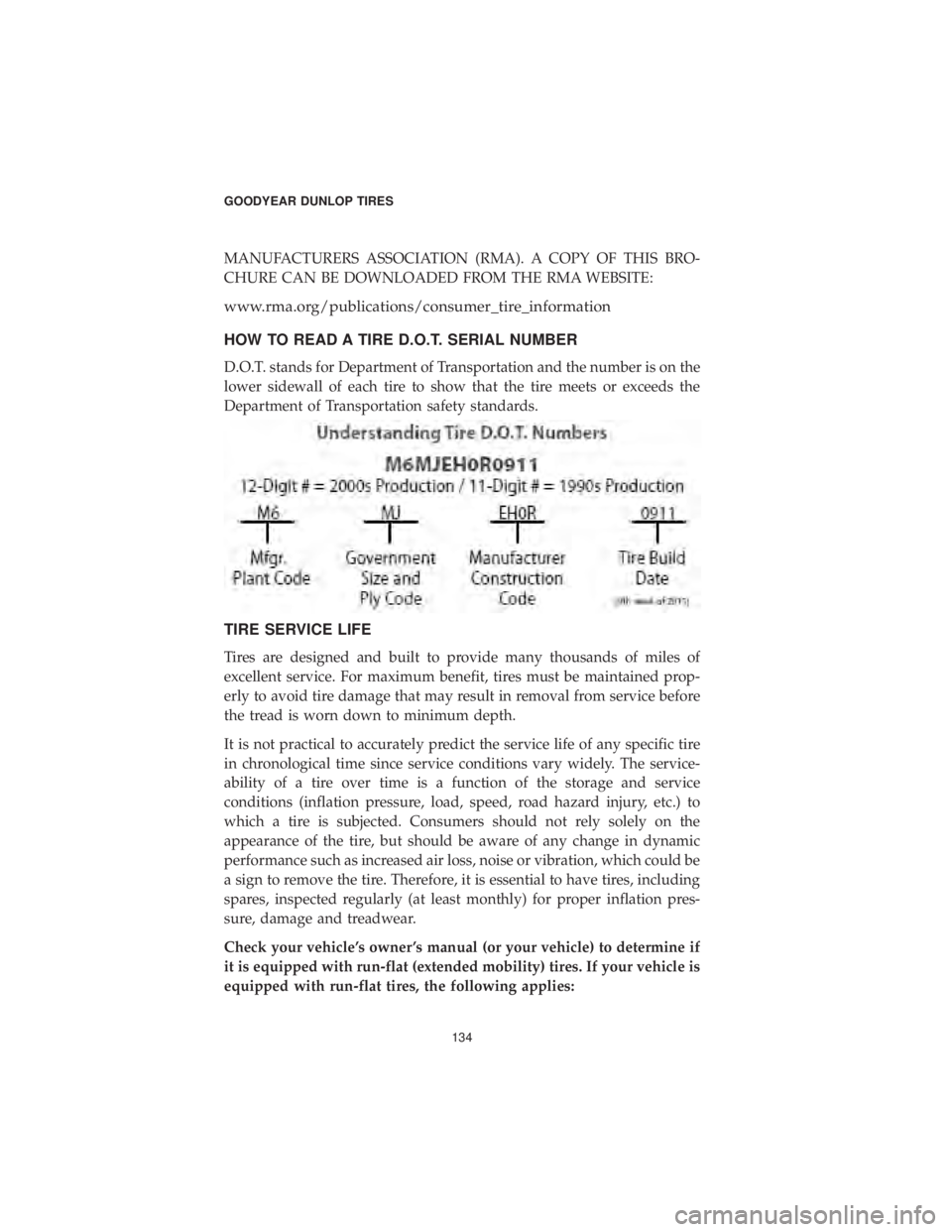
MANUFACTURERS ASSOCIATION (RMA). A COPY OF THIS BRO-
CHURE CAN BE DOWNLOADED FROM THE RMA WEBSITE:
www.rma.org/publications/consumer_tire_information
HOW TO READ A TIRE D.O.T. SERIAL NUMBER
D.O.T. stands for Department of Transportation and the number is on the
lower sidewall of each tire to show that the tire meets or exceeds the
Department of Transportation safety standards.
TIRE SERVICE LIFE
Tires are designed and built to provide many thousands of miles of
excellent service. For maximum benefit, tires must be maintained prop-
erly to avoid tire damage that may result in removal from service before
the tread is worn down to minimum depth.
It is not practical to accurately predict the service life of any specific tire
in chronological time since service conditions vary widely. The service-
ability of a tire over time is a function of the storage and service
conditions (inflation pressure, load, speed, road hazard injury, etc.) to
which a tire is subjected. Consumers should not rely solely on the
appearance of the tire, but should be aware of any change in dynamic
performance such as increased air loss, noise or vibration, which could be
a sign to remove the tire. Therefore, it is essential to have tires, including
spares, inspected regularly (at least monthly) for proper inflation pres-
sure, damage and treadwear.
Check your vehicle’s owner ’s manual (or your vehicle) to determine if
it is equipped with run-flat (extended mobility) tires. If your vehicle is
equipped with run-flat tires, the following applies:
GOODYEAR DUNLOP TIRES134
Page 136 of 270

RUN-FLAT TECHNOLOGY EXTENDED MOBILITY TECHNOLOGY
(EMT™), RUNONFLAT® (ROF) AND DUNLOP SELFSUPPORTING
TECHNOLOGY (DSST®) ORIGINAL EQUIPMENT TIRES
IMPORTANT SAFETY INFORMATION
OPERATIONAL MONITORING
The information contained in this Limited Warranty Brochure applies
only to the Original Equipment tires supplied with your vehicle. In order
for Goodyear Run-Flat (Extended Mobility Technology [EMT], RunOn-
Flat [ROF]) or Dunlop Run-Flat (Dunlop Self- Supporting Technology
[DSST]) tires to obtain the performance criteria stated within this Limited
Warranty, Goodyear or Dunlop Run-Flat tires must use specific parts,
such as a low tire pressure monitoring system authorized by the Original
Equipment vehicle manufacturer.
RUN-FLAT TIRE FEATURE:
The Goodyear or Dunlop Run-Flat tire is a high-performance tire with a
remarkable feature: It can operate for limited distances with very low or
even no inflation pressure (refer to your Vehicle Owner ’s Manual for
these limitations). This is an important benefit, especially if inflation loss
occurs at a location where immediately stopping your vehicle could be
hazardous. TIRE PRESSURE MONITORING SYSTEM ALERT Refer to
your vehicle Owner ’s Manual for more information on what to do if the
tire pressure warning system activates.
WARNING!
If the tire pressure-monitoring system signals an alert, follow these
safety precautions to prevent a loss of vehicle control that could
result in serious personal injury or death:
•Slow your speed. Do not exceed 50 mph (80 kph).
• Avoid hard cornering, hard braking and severe handling maneu-
vers.
• Avoid potholes and other road hazards.
Remember that when your tires have lost air pressure, your vehicle’s
handling capability is reduced, particularly during severe
maneuvers.
GOODYEAR DUNLOP TIRES
135